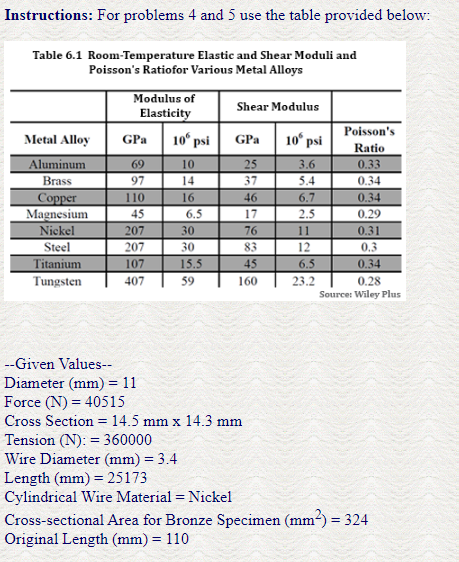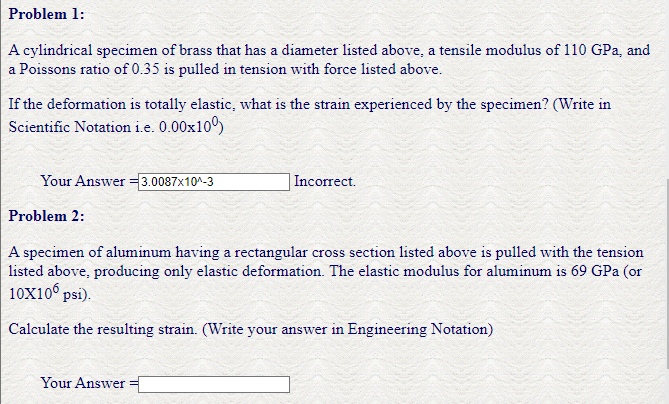Answered step by step
Verified Expert Solution
Question
1 Approved Answer
Instructions: For problems 4 and 5 use the table provided below: Table 6.1 Room-Temperature Elastic and Shear Moduli and Poisson's Ratiofor Various Metal Alloys



Instructions: For problems 4 and 5 use the table provided below: Table 6.1 Room-Temperature Elastic and Shear Moduli and Poisson's Ratiofor Various Metal Alloys Modulus of Shear Modulus Elasticity Poisson's Metal Alloy GPa 10 psi GPa 10 psi Ratio Aluminum 69 10 25 3.6 0.33 Brass 97 14 37 5.4 0.34 Copper 110 16 46 6.7 0.34 Magnesium 45 6.5 17 2.5 0.29 Nickel 207 30 76 11 0.31 Steel 207 30 83 12 0.3 Titanium 107 15.5 45 6.5 0.34 Tungsten 407 59 160 23.2 0.28 Source: Wiley Plus --Given Values-- Diameter (mm) = 11 Force (N) 40515 Cross Section 14.5 mm x 14.3 mm Tension (N): 360000 Wire Diameter (mm) = 3.4 Length (mm) 25173 Cylindrical Wire Material = Nickel Cross-sectional Area for Bronze Specimen (mm) = 324 Original Length (mm) = 110 Problem 1: A cylindrical specimen of brass that has a diameter listed above, a tensile modulus of 110 GPa, and a Poissons ratio of 0.35 is pulled in tension with force listed above. If the deformation is totally elastic, what is the strain experienced by the specimen? (Write in Scientific Notation i.e. 0.00x100) Your Answer 3.0087x10^-3 Incorrect. Problem 2: A specimen of aluminum having a rectangular cross section listed above is pulled with the tension listed above, producing only elastic deformation. The elastic modulus for aluminum is 69 GPa (or 10X10 psi). Calculate the resulting strain. (Write your answer in Engineering Notation) Your Answer Problem 3: Consider a cylindrical wire of the given material with the diameter and length provided above. Calculate its elongation when a load of 500 N is applied. Assume that the deformation is totally elastic and that the elastic modulus is listed on the table above. (Answer in mm) Your Answer = Problem 4: For a bronze alloy, the stress at which plastic deformation begins is 275 MPa and the modulus of elasticity is 116 GPa. What is the maximum load that can be applied to a specimen having a cross-sectional area listed above without plastic deformation? (Answer in Newtons) Your Answer: Problem 5: For a bronze alloy, the stress at which plastic deformation begins is 275 MPa and the modulus of elasticity is 115 GPa. If the original specimen length is listed above, what is the maximum length to which it may be stretched without causing plastic deformation? (Answer in mm) Your Answer
Step by Step Solution
There are 3 Steps involved in it
Step: 1
Sol...
Get Instant Access to Expert-Tailored Solutions
See step-by-step solutions with expert insights and AI powered tools for academic success
Step: 2

Step: 3

Ace Your Homework with AI
Get the answers you need in no time with our AI-driven, step-by-step assistance
Get Started


